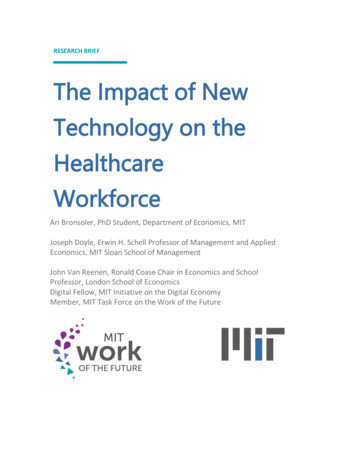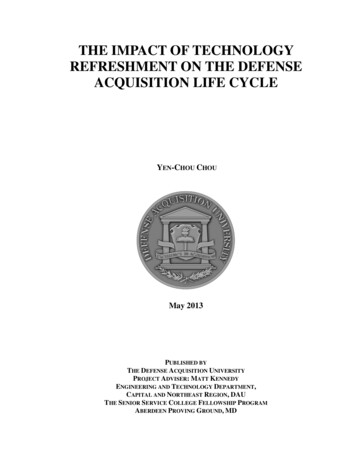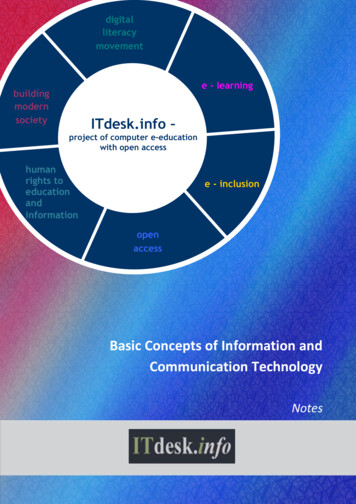
Transcription
RESEARCH BRIEFThe Impact of NewTechnology on theHealthcareWorkforceAri Bronsoler, PhD Student, Department of Economics, MITJoseph Doyle, Erwin H. Schell Professor of Management and AppliedEconomics, MIT Sloan School of ManagementJohn Van Reenen, Ronald Coase Chair in Economics and SchoolProfessor, London School of EconomicsDigital Fellow, MIT Initiative on the Digital EconomyMember, MIT Task Force on the Work of the Future
The Impact of New Technology on the Healthcare Workforce:Ari Bronsoler1, Joseph Doyle2, and John Van Reenen31MIT, 2MIT,and 3NBER, MIT, and LSEAbstractDramatic improvements in information technology have the potential to transform healthcare delivery, anda key question is how such changes will affect the healthcare workforce of the future. In this brief, wepresent the state of knowledge of the effects of health information technology on the workforce. We firstlay out the rapidly changing healthcare landscape due to the greater availability and use of informationand communication technology (ICT) followed by a description of the evolution of employment, wages, andeducation across the wide variety of occupations in the healthcare sector since 1980. The healthcare sectorhas outperformed the rest of the economy and has proven resilient to the multiple downturns over the lastfour decades, although some groups have done much better than others. Next, we review the literature onthe effects of ICT on productivity in terms of patient health outcomes and resource use, as well as theeffects on healthcare expenditure. We find that there is evidence of a positive effect of ICT (e.g.,especially electronic health records) on clinical productivity, but (i) it takes time for these positive effects tomaterialize; and (ii) there is much variation in the impact, with many organizations seeing no benefits.Looking at the drivers of adoption, we find that the role of workers is critical, especially physicians’attitudes and skills. Privacy laws, fragmentation, and weak competition are also causes of slow adoption.There is very little quantitative work that investigates directly the impact of new technology on workers’jobs, skills, and wages, but what there is suggests no substantial negative effects. Our own analysis finds noevidence of negative effects looking at aggregate data and hospital-level event studies. These findingsare consistent with studies outside of healthcare, which stress the importance of complementary factors(such as management practices and skills) in determining the success of ICT investments. We conclude thatmanagement initiatives to increase the skills of workers will be required if the healthcare workforce andsociety more generally are to substantially benefit from the adoption of these powerful tools.Acknowledgments: We thank the MIT Task Force on the Work of the Future for financial support andcomments on earlier drafts. We have benefited immensely from discussions with Catherine Tucker andCason Schmit. Leila Agha, David Autor, and Tom Kochan have also given generous and detailed comments.2
I. IntroductionDuring the coronavirus pandemic, the importance of health and healthcare as fundamental supports todaily activities became particularly stark. The healthcare workforce has taken center stage by takingpersonal risks to help stem the spread of COVID-19, and new communication technologies such astelehealth have become very widespread. Meanwhile, great hopes are placed on innovation to provide asolution in the form of therapies and vaccines. A longer-term question is how the future of technologicaldevelopment will affect the healthcare workforce. The aim of this research brief is to consider the state ofknowledge on this question and offer a path forward to understand and be prepared for these comingchanges.It has long been recognized that healthcare holds enormous potential for the beneficial impacts of newtechnologies. Healthcare accounts for nearly one in every five dollars spent in America. Therefore,improvements in this sector have first-order effects on economic performance through sheer scale.Furthermore, like almost every other country, the proportion of national income absorbed by healthcareappears on an almost inexorable upwards trend. According to the National Health Expenditure Accounts,the fraction of GDP spent on healthcare has risen by about four percentage points every 20 years: from5% in 1960 to 9% in 1980, 13% by 2000, and then to nearly 18% today. This is driven by the agingpopulation, costs of new technologies, and a natural tendency for humans to increase the fraction of theirbudgets on health as they grow richer—after all, there are only so many consumer goods one can have(Hall and Jones, 2007).The United States has long stood out from other Organisation for Economic Co-operation andDevelopment (OECD) countries in that it spends a larger fraction of income on health. It also achievesrelatively disappointing results for this high expenditure. For example, improvements in life expectancy inthe United States appear to have stalled, in stark contrast to the experience of other nations (Case andDeaton, 2020).In light of these trends, policymakers have stressed the use of information and communication technology(ICT) in healthcare as a mechanism to improve efficiency and clinical outcomes. In some sense, thisculminated with the 2009 Health Information Technology for Economic and Clinical Health (HITECH) Act,part of the Affordable Care Act (colloquially known as “Obamacare”), which spent around 30 billion toincrease the take-up of electronic health records (EHRs). Although ICT has been used in healthcare since atleast the early 1960s, fewer than 10% of hospitals (and fewer than 20% of physicians) were using EHRsprior to HITECH (Atasoy et al., 2019). By 2014, 97% of reporting hospitals had certified EHR technology(Gold and McLaughlin, 2016).3
An aim of HITECH was to increase adoption rates by subsidizing ICT acquisition costs, changingreimbursement rules, and providing technical support. It emphasized the adoption of decision supportcapabilities and utilization at the point of care, formally referred to as “meaningful use.” Jha et al. (2010)estimate that fewer than 2% of hospitals met the criteria of meaningful use prior to the Act, and the rise inhealth ICT capabilities provides an opportunity to investigate the effects of such subsidies on healthcareproductivity in general and the workforce in particular.There is some reason for optimism that ICT can substantially improve the productivity of healthcare. Apartfrom sheer scale, an advantage for tech applications is that healthcare is a knowledge-intensive industrycharacterized by fragmented sources of information (Atasoy et al., 2019). Therefore, in principle, it isperfect for the application of ICT. The enormous decline in the quality-adjusted price of ICT(approximately 15% per annum since 1980 and up to 30% per annum between 1995 and 2001) istherefore a boon to the sector (e.g., Bloom, Sadun, and Van Reenen, 2012). Indeed, after the success ofIBM Watson’s Artificial Intelligence computer on the television quiz show Jeopardy, the first commercialapplication announced was in healthcare (IBM Watson Health1). In a well-known RAND study, Hillestad etal. (2005) estimated that IT adoption could save between 142 billion and 371 billion over a 15-yearperiod.2 However, despite the enormous potential and investments, the results of the impact of health ICThave been disappointing. A subsequent RAND study by Kellermann and Jones (2013) shows that thepredicted savings had not materialized due, in part, to a lack of information sharing across providers anda lack of acceptance by the workforce in an environment where incentives run counter to the goal ofreducing healthcare costs. Lessons from other industries suggest that the management of new technologies isan important driver of ICT productivity gains, and there are serious issues of management quality in thehealthcare sector (e.g., Bloom et al., 2020).HEALTHCARE WORKFORCE OF THE FUTUREThe scale of healthcare is seen in the sheer number of jobs attributed to the healthcare sector: 11% of allU.S. employment (see Section III for a more detailed analysis). In addition to size, jobs in healthcare aregenerally regarded as “good jobs,” even for relatively less skilled workers, with reasonable wage andnonwage benefits. One of the great fears of our age is the potential for machines to replace human jobsand lead to mass unemployment. Even if this were true in general, and history suggests that it is not, thegrowth in the number of jobs in healthcare means that new technologies in healthcare would primarily slowdown the growth of employment rather than reduce it. In any event, the rise of new technologies inhealthcare has the potential to benefit the workforce across a wide range of skills, but it will be importantto manage the change brought on by innovations in the sector.This research brief provides background on the latest developments in new information technologies andworkforce trends in healthcare. We will consider lessons from other industries as well as findings specific to4
healthcare ICT adoption. We hope that this will provide a basis to understand the potential changes thatwill affect the workforce in the future, depending on how such changes are managed. One lesson from ourreview of the literature is that the current evidence on the impact of health IT on the workforce is verysparse indeed; we need a renewed emphasis to examine the impact of past (and more speculativelycurrent and future) technologies on the healthcare workforce.The structure of this brief is as follows: Section II provides a summary of the evolution of health IT and asummary of what is known about the effects of health IT on productivity. Section III provides the context ofthe evolution of the healthcare workforce since 1980 in terms of jobs, wages, and education. Section IVdescribes the findings of our literature review on the impacts of health IT on healthcare productivity andthe workforce. In Section V, we present our own findings of the impact of health IT adoption on theworkforce, and Section VI concludes.II. The Recent Evolution of Health Information TechnologyII.1. NEW HEALTH INFORMATION TECHNOLOGIESII.1.1. Electronic Health RecordsThe electronic health record, or EHR, is, at its core, a digitized medical chart. Deriving value from thistechnology requires a broad array of functions that gather, manage, and share digital health information.This information can then be exploited to support medical decision-making and operations. Ideally,information gathering begins before a patient encounter: retrieving records from other providers or pastpatient encounters. This, and other information, is then updated at the beginning of the patient’s interactionwith the physician or nursing staff; additional data—such as lab values, images, and progress notes—areadded as the encounter progresses. This data could, ideally, be made portable so that it may be sharedwith other providers or accessed via patient portals.Figure 1 below shows how EHR adoption has dramatically increased over the 2003–2017 period,particularly after the HITECH Act. We report three series. First, the “official” measure from the Office ofthe National Coordinator for Health Information Technology, which presents the fraction of hospitals usingEHR (with a correction for nonrandom sample response) from a large survey of hospitals, the AmericanHospital Association (AHA) Annual Survey Information Technology (IT) Supplement, or AHA IT SupplementSurvey, from 2008 onwards.3 Second, we present our own analysis of the AHA IT Supplement Survey, aswell as (our third series) a similar definition using another large survey of hospitals carried out by theHealthcare Information and Management Systems Society (HIMSS), which allows us to cover a longer timeseries, from 2003 onwards. Although the precise levels of these series differ, the broad trends are similar,showing a strong increase in adoption over this period, with a particularly big boost after the HITECH Act,which was implemented in 2010. 45
Figure 1: Cumulative Adoption of Electronic Health Records (EHRs)Notes: This figure presents estimates of the fraction of hospitals that were using “basic” EHRs (electronic healthrecords) in the year indicated in different databases. The basic EHR is defined as the use of physician documentationand computerized physician order entry (CPOE). The squares are official estimates from the Office of the NationalCoordinator for Health Information Technology (re-weighted to correct for nonrandom sample response). The circlesare our own estimates from the AHA IT Supplement Survey, and the triangles are our own estimates from HIMSS. Thevertical axis is set so that 1 100% (complete adoption).The HITECH Act’s intention was to encourage hospitals to adopt and use EHRs meaningfully by committingaround 30 billion in incentives (Wani and Malhotra, 2018). 5 The program is based on three main stages.Stage 1 established requirements for the electronic capture of clinical data. In order to achieve successfulfirst-stage attestation, hospitals were required to enter medication orders electronically for at least 80%of their patients and have electronic discharge instructions and health records for 50% of them. Theseincentives were structured to encourage early adoption, as hospitals that achieved these benchmarks by2011 received 100% of the incentive payment, which declined 25% each additional year until adoption.After 2015, penalties were imposed: Hospitals that still failed to achieve the benchmarks started to lose1% of Medicare reimbursements each year. In order to achieve the goals, core technologies needed to beadopted, including electronic medication administration record (eMAR), clinical data registry (CDR), clinicaldecision support (CDS), and computerized physician order entry (CPOE).6
The second and third stages elevate the benchmarks. Stage 2 focused on advancing clinical processes andencouraging health information exchange in a highly structured format. Stage 3 focused on using certifiedelectronic health records to improve health outcomes. According to the Office of the National Coordinatorfor Health Information Technology (2017), as of 2016, over 95% of hospitals had achieved meaningfuluse of certified health IT, while nearly 90% of hospitals had reached Stage 2 certification. Figure 2 showsthat achieving higher stages is correlated with hospital size.Figure 2: Meaningful Use (MU) Certification by Size, Type, and Urban/Rural LocationNotes: This figure presents meaningful use attestation status by size/type and urban/rural location hospitalsaccording to the health IT dashboard in 2016. The categories are hierarchical and mutually exclusive. Adopt,Implement, Upgrade (AIU) incentives are paid in the first year a hospital is part of the program, prior to attainingStage 1 or Stage 2 performance. ice-setting-area-type.phpWith such rapid, federally subsidized growth in health IT adoption, there is considerable policy interest inwhether organizations are learning to use the new tools in ways that can improve healthcare productivityand how these new technologies are affecting the healthcare workforce.II.1.2. Clinical Decision Support (CDS)As noted above, EHRs may serve as a platform for decision support: Established clinical guidelines or bestmedical practices may be operationalized within the EHR software using patient-level data to promptproviders with suggestions or raise flags regarding potentially risky interventions or inappropriate imaging7
(Doyle et al., 2019). These capabilities depend on detailed patient information and a provider interfaceat the point of care.CDS can also support a broad range of functions, such as pre-specified order sets—a package of testsand subsequent procedures that can be chosen in an order-entry system with one click (e.g., commonpostoperative monitoring and care). These order sets, properly chosen by clinicians within health systems,may help implement evidence-based guidelines and best practice protocols, as well as reduce unwantedvariation in practice across clinics or physicians.There is evidence that CDS improves patient safety for medication prescribing (Campanella et al., 2016).For example, algorithms can check for drug allergies or drug-to-drug interactions and dosage errorsthrough automated dosage calculators. These capabilities can improve medical adherence and reducemedication overuse (Atasoy et al., 2019).Mirroring the overall concerns with ICT acceptance by the workforce, a key concern is alert fatigue andcognitive overload. Computer systems generate alerts when there is a suspected mistake (e.g., orderingtoo high a dosage of a drug), but if the thresholds are set too low, then the alerts may be too frequent. ForEHR, most of the alerts appear to be overridden in practice. Ancker et al. (2017) find that the likelihood ofacceptance of a best-practice advisory goes down by 10 percent with each 5% increment in within-patientrepeats, while it goes down by 30% with each additional suggestion. Although overrides are frequentlyjustified, they can be associated with medication errors and adverse events (including death) if clinicallyimportant information is advertently ignored.II.1.3. New Communication Technologies: The Example of TelehealthMiscommunication is common in a complex system like modern medicine. McCullough et al. (2010) explainthat the U.S. healthcare system is often criticized for miscommunication that leads to preventable medicalerrors and wasteful allocation, including part of the estimated 44,000 deaths annually due to inpatienthospital errors. For example, a prescription requires a physician, a pharmacist, and a nurse to coordinate.EHR can resolve this in principle—likely a substantial improvement from the days of illegible handwriting.Similarly, computerized physician order entry (CPOE) offers a more efficient way for physicians tocommunicate orders that may help prevent mistakes. McCullough et al. (2010) report small but significantimprovements in quality because of CPOE. While such systems likely reduce errors, continued managementof these systems is necessary to ensure safety. A dramatic example was described by Wachter (2017)involving a series of mistakes caused by EHR that nearly led to the death of 16-year-old Pablo Garcia atthe UCSF Medical Center in 2013.6In addition, telemedicine provides a new platform to deliver healthcare at a distance. The coronaviruspandemic has seen rapid take-up of telemedicine in the United States and around the world, and this islikely to persist even after the pandemic has abated. 7 Often, large and sudden shocks can help the switch8
to a new adoption equilibrium as it gives multiple players simultaneous incentives to switch to using the newtechnology (e.g., physicians, patients, and hospital managers). In particular, the decision by Medicare toreimburse telehealth visits during the pandemic provides a valuable opportunity for providers to offer suchcare in lieu of in-person visits. Key players in this switch are federal and local regulators. The rapidchanging of regulations to facilitate telemedicine suggests that regulatory barriers have been part of thereason for the slow diffusion of telemedicine and perhaps health ICT more generally (Cutler et al., 2020;Keesara et al., 2020).Telehealth is particularly attractive for patients in hard-to-reach communities who can be treated via avideo connection. Telemedicine allows physicians to receive consultations from specialists (Long et al.,2018). For example, Telestroke connects specialists to clinicians at the bedside of a stroke patient whiletransferring key clinical indicators in real time, which enables distant specialists to provide advice ontreatment decisions. Baratloo et al. (2018) offer a review of 26 studies that analyze the program andargue that telemedicine can improve stroke care in regional areas with limited experience in thrombolysis.II.1.4. Information Management and Healthcare AnalyticsWith information moving from paper to digital records, health IT opens new doors to manage and minedata with new powers of diagnosis and treatment recommendations. This is particularly relevant forcomplex patients with multiple comorbidities and those who require intensive monitoring and testing. Datacan be more easily captured, organized, and analyzed. Furthermore, now that EHR adoption iswidespread, these systems provide a basis for data analytics that may lead to large long-run gains inhealthcare quality and efficiency, including better-informed policy design.Diabetes serves as an example to illustrate many advantages of information technology. Rumbold,O’Kane, Philip, and Pierscionek (2020) explain that machine-learning algorithms can capture blood sugarmeasurements daily and help predict with greater confidence who will develop a complication. This allowstreatment such as medication choice and dosing to be personalized to each patient. Moreover, technologynow allows patients to carry their information on their cellphones, receive alerts and reminders oftreatment, and track their health status. Such apps have the potential to improve treatment adherence.Another prominent example of the use of healthcare analytics that benefits from the storage andanalytical capabilities of health IT comes from the field of radiology. Machine learning in general hasachieved substantial gains in image recognition, and allowing machine-learning algorithms to flag concernsin images provides a powerful tool that has the potential to increase the productivity of radiologists (andpotentially lead to job displacement; see Section III). A related example is offered by Rumbold et al.(2020) who explain how machine-learning algorithms can improve the detection of diabetes complicationsfrom retinal images.9
II.1.5. Health IT and Public Health SurveillanceFrom a public health surveillance viewpoint, Gamache, Kharrazi, and Weiner (2018) argue that the abilityto capture where each case is happening and how the population characteristics are evolving allowsgovernments to make more informed public policy choices. For example, O’Donovan and Bersin (2015)explain how technology can play a key role in mitigating an Ebola outbreak. By allowing freecommunication between the government and citizens, cellphones provided an effective way to track anepidemic and provide useful information to citizens on how to stay safe. In the midst of the currentpandemic, an unprecedented effort on increasing surveillance capabilities has taken place worldwide asseveral governments use contact-tracing apps that help them identify potentially sick individuals. Countriessuch as South Korea, Singapore, and China have aggressively used track, trace, and testing to control theCOVID-19 pandemic.II.2. CHALLENGES AND DRIVERS OF ICT ADOPTION AND MEANINGFUL USEOur review of the literature described below suggests that health IT appears to have had modestimprovements in productivity measured by health outcomes and clinical quality, and mixed effects onhealthcare spending. Meanwhile, the impacts of health IT on the workforce itself has been much lessstudied. To make further progress in understanding the effects of health IT on this range of outcomes, it isuseful to understand what drives the diffusion of the technology.The factors that affect the adoption of health IT are similar to those in the broader literature ontechnological diffusion (e.g., see Hall, 2005; for a survey). Complexity, cost, competition, andcomplementary factors (such as skilled labor) are all important. For example, given the high fixed costs ofadoption, it is no surprise that larger organizations are more likely to adopt IT, while stand-alone hospitalsystems are less likely to adopt administrative and strategic health IT (Hikmet, Bhattacherjee and Kayhan,2008).This section builds on Gnanlet et al. (2019), which reviewed the literature covering 37 recent papers. Wewill discuss some of the broader issues affecting IT adoption, as well as healthcare-specific factorsidentified in the literature.Patient SafetyAlthough health IT offers the potential to improve patient safety substantially (Bates and Gawande, 2003),there is a risk that errors may be introduced (Harrington et al., 2011). The initial adjustment costs in mostindustries as firms learn how to use IT are well documented, and this appears to be the case in healthcareas well. However, because patient safety may be affected by such a transition, there is a natural tendencytoward greater risk aversion to all sorts of change, including technology in the health sector.10
Patient PrivacyA common concern that affects health IT adoption revolves around privacy. Congress passed a federallaw, the Health Insurance Portability and Accountability Act (HIPAA), in 1996 to aid in the sharing of healthdata by establishing some rules of the road. States also passed privacy laws, and the sheer complexity oflegal obligations is thought to reduce the benefits of data sharing and, thus, health IT adoption (Schmit etal., 2017, 2018). Miller and Tucker (2009, 2011) investigated the role of state privacy laws followingHIPPA. They argue that restricting hospital release of information reduced IT adoption by about 24%. Themain reason they offer is that the gain to a network from adopting EHR is that systems can interoperatewithin the network across disparate hospitals and other providers. However, these interoperability benefitsare undermined when privacy laws are very restrictive, so hospitals have much less incentive to adopt EHR.Market ConcentrationThe EHR market features two dominant firms, Epic and Cerner. Many have argued that this lack of robustcompetition raises prices and thereby slows adoption. The effects of competition on the quality of EHRsystems is more ambiguous, but if investing in raising quality is more costly than the improved revenues thatwould result from greater demand, then a lack of quality-improving investments is another way thatadoption might be slowed. Improving interoperability standards could be a major area where governmentregulation could overcome the frictions that sustain market concentration.On the demand side, a few large providers similarly dominate some healthcare markets. Zhivan andDiana (2012) argue that more inefficient hospitals are more likely to adopt EHR; so to the extent thatmore concentrated markets allow more inefficient firms to survive, that would work to speed the adoption.Finally, there has been some concern that health ICT in general and the HITECH Act specifically haveaccelerated the consolidation of physician practices, as small practices have greater difficulty coveringhigh fixed cost investments in ICT. These investments are increasingly rewarded, in the setting of HITECHAct incentive and penalty payments, as well as various pay for performance systems, including the Meritbased Incentive Payment System (MIPS) (Johnston et al., 2020). Case studies suggest that the need for EHRinvestment is a major motivation for small practices seeking to be acquired by a large integrated caresystem (Christianson et al., 2014). As a result, one indirect way that health ICT may reshape the healthcareworkforce is by changing firm size and employment relationships.ManagementMany lessons can be learned from other industries when looking at the ICT revolution. For many decades,the Solow Paradox ruled: We could see computers everywhere apart from the productivity statistics. In themacroeconomic productivity numbers, we did not see serious impacts on productivity until after 1995, whenthere was a near doubling of U.S. productivity growth (at least through 2004), which was focused on the11
industries that intensively used or produced ICT (Oliner et al., 2007). And this lag in productivity gains fromnew technologies is nothing new. Economic historians like Paul David (1990) point to similarly long lagsfrom other major technological revolutions such as electricity.From the mid-1990s, the macroeconomic productivity improvements from ICT were becoming statisticallyvisible; a large number of microeconometric studies were also uncovering large returns to ICT investments,albeit with long time lags. Digging deeper into these microstudies reveals that although on average therewas a positive effect of ICT on firm performance, the impact was extremely heterogeneous (see the surveyin Draca et al., 2007; Brynjolfsson and Hitt, 2000). Some firms could spend huge amounts on ICT andreceive very little return. One important factor in explaining this variation were the bottlenecks that firmsfaced in best using the opportunities new technologies created. Particular bottlenecks were rigidorganizations (poor management practices) and the wrong sort of skills (e.g., Bresnahan et al., 2002;Caroli and Van Reenen, 2001). The firms that were best able to exploit the new technologies were thosethat could adapt by changing their organization and skill mix.A similar story reveals itself in healthcare. Gnanlet et al. (2019) argue that there are three inter-relatedstages of IT implementation: adoption, integration, and sustenance. Major impediments for success includeprovider resistance in the integration stage and lack of interoperability in the sustenance stage.New technologies often create winners and losers—some are deskilled and some are reskilled; some mightgain responsibility and remuneration while others might lose it (in the extreme case losing their jobsentirely). Having to change one’s routines and learn complex new systems can be burdensome, to say theleast (Gawande, 2018).8 Kroth et al. (2018) report that 56% of doctors complained about excessive timespent on EHR. A recu
The Impact of New Technology on the Healthcare Workforce: Ari Bronsoler1, Joseph Doyle2, and John Van Reenen3 1MIT, 2MIT, and 3NBER, MIT, and LSE Abstract Dramatic improvements in information technology have the potential to transform healthcare delivery, and a key question is how such ch










